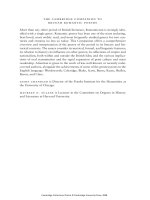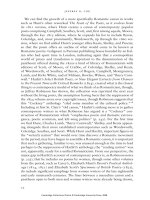The cambridge companion to british roman 44
Bạn đang xem bản rút gọn của tài liệu. Xem và tải ngay bản đầy đủ của tài liệu tại đây (38.76 KB, 1 trang )
j e f f r e y n . c ox
We can find the growth of a more specifically Romantic canon in works
such as Hunt’s often reworked The Feast of the Poets, as it evolves from
its 1811 version, where Hunt creates a canon of contemporary popular
poets comprising Campbell, Southey, Scott, and, first among equals, Moore,
through the key 1815 edition, where he expands his list to include Byron,
Coleridge, and, most prominently, Wordsworth, up through the 1860 version, where we find added Hunt’s younger allies Keats, Shelley, and Procter,
so that the poem offers an outline of what would come to be known as
Romantic poetry. Galignani (a Parisian publishing house founded by an Italian who had spent time in London, indicating again that a cosmopolitan
world of piracy and translation is important to the dissemination of the
pantheon) offered during the 1820s a kind of library of Romanticism with
editions of Scott, of Moore, of Crabbe, of Coleridge, Shelley, and Keats,
of Wordsworth, of Southey, of Byron, of Rogers, Campbell, Montgomery,
Lamb, and Kirke White, and of Milman, Bowles, Wilson, and “Barry Cornwall.” Hazlitt’s Select British Poets, or New Elegant Extracts from Chaucer
to the Present Time with Critical Remarks (1824), created what is the closest
thing to a contemporary model of what we think of as Romanticism, though,
as Jeffrey Robinson has shown, the collection was reprinted the next year
without the living poets, the assumption having been that the suppression of
the 1824 volume arose over copyright issues, though Robinson suggests that
this “Cockney” anthology “riled some member of the cultural police.”18
Including at first St. Clair’s “old canon,” Hazlitt’s striking move is to gather
contemporary writers in what Robinson has argued is a “Cockney” construction of Romanticism which “emphasizes poetic and thematic extravagance, poetic eroticism, and left-wing politics” (p. 243). For the first time
we find Hunt, Charles Lamb, “Barry Cornwall,” Shelley, and Keats appearing alongside their more established contemporaries such as Wordsworth,
Coleridge, Southey, and Scott. While Hunt and Hazlitt, important figures in
the “writerly nation” that would over time discover a Romantic movement
in the period, may have begun to assemble a Romantic canon, it is important
that such a gathering, familiar to us, was unusual enough at the time to lead
perhaps to the suppression of Hazlitt’s anthology; the “reading nation” was
not, apparently, ready for a unified Romanticism. From our perspective, the
major gap in Hazlitt’s account of contemporary poetry is, as Robinson notes
(p. 233), that he includes no poems by women, though some other volumes
from the period, such as Carey’s, Elizabeth Mant’s Parent’s Poetical Anthology (1814, 1821) and Elizabeth Scott’s Specimens of British Poetry (1823),
do include significant samplings from women writers of the late eighteenth
and early nineteenth centuries. The lines between a masculine canon and a
pantheon open to both men and women writers were already being drawn,
22
Cambridge Collections Online © Cambridge University Press, 2008









